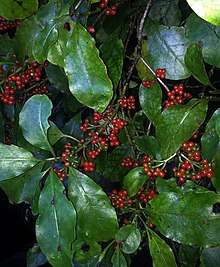Izatha austera
Izatha austera is a species of moth in the family Oecophoridae. It is endemic to New Zealand. The larvae of this species feed on dead wood by tunnelling into branches of its host species. The larvae matures from September and is on the wing in the months of December to January. The adult moth is variable in colouration but is seldom observed.
| Izatha austera | |
|---|---|
.jpg) | |
| Scientific classification | |
| Kingdom: | |
| Phylum: | |
| Class: | |
| Order: | |
| Family: | |
| Genus: | |
| Species: | I. austera |
| Binomial name | |
| Izatha austera | |
| Synonyms[2] | |
| |
Taxonomy
I. austera was first described, as Semiocosma austera, by Edward Meyrick in 1883, in brief, and again in greater detail in 1884.[3][4] Meyrick used two specimens collected in the Botanic Garden and forest in Wellington in January.[4][2] The lectotype specimen is held at the Natural History Museum, London.[2] George Hudson discussed and illustrated this species in 1928.[5]
Description
.jpg)
Hudson described the larvae as follows:
Its length is slightly over 1⁄2 in. ; slender and cylindrical ; the head is reddish-brown, highly polished ; the second segment dark brown and horny ; the third segment has two triangular brown horny dorsal plates ; the rest of the body dull ochreous, with a very broad slaty-black dorsal band and four conspicuous horny dorsal tubercles ; the terminal segment is horny, yellowish-brown ; there is a series of conspicuous lateral tubercles and a whitish lateral ridge ; all the tubercles emit long yellowish-brown bristles.[5]
Meyrick described the adults of the species as follows:
Male. — 17-18 mm. Head, antennae, thorax, and abdomen dark fuscous. Palpi dark fuscous, second joint mixed with pale ochreous, terminal joint with a suffused pale ochreous band above and below middle. Legs dark fuscous, median ring of tibiae and apex of all joints whitish-ochreous. Forewings moderate, costa gently arched, apex rounded, hindmargin oblique, hardly rounded ; dull fuscous, mixed with darker and lighter ; the lighter tint appears to form an obscure transverse fascia before middle parallel to hindmargin, and a curved transverse line from 3/4 of costa to before anal angle ; a tuft of dark fuscous scales beneath fold at 1/3 ; an arched dark fuscous mark in disc beyond middle ; hindmargin and apical fourth of costa obscurely spotted with darker : cilia fuscous, with a darker line. Hindwings dark fuscous, somewhat lighter towards base ; cilia fuscous, with a cloudy darker line.[4]
The wingspan is 13–19 mm for males and 16.5–25 mm for females.[6] This species is variable in its forewing colouration.[5] I. austera also has noticeable scale-tufts on its forewing.[6] It can be confused with I. dasydisca but the male can be distinguished as it has blackish coloured antennae, a scale-tuft on the third segment of the labial palp, and lacks the pair of large scale-tufts that I. dasydisca has on its forewings.[6]
Distribution
I. austera is endemic to New Zealand.[1][7] This species is widespread throughout the North Island, with a single South Island record from north-west Nelson.[6] This species is present in Northland, Auckland, Coromandel, Waikato, Bay of Plenty, Taranaki, Taupo, Gisborne, Hawkes Bay, Rangitikei, Wellington and Nelson districts.[6]
Biology and behaviour

Larvae live in silken tubes under the bark of dead branches of its host species.[5] The larvae live during winter months and are mature by the end of September.[5] Adults are on wing from December to February.[6] This species have been collected via sugar traps or by beating shrubs during the daytime.[5] I. austera only comes sparing to light.[6] When resting on bare tree trunks the adult moth is very inconspicuous.[5]
Habitat and host species
Larvae feed during the winter in dead wood, including moist logs on the forest floor, and drier standing dead wood.[8] They have been recorded from dead branches of Aristotelia serrata, Coprosma grandifolia and probably Coprosma robusta, Cordyline australis, Coriaria arborea, Laurelia novae-zelandiae, Litsea calicaris, Melicytus ramiflorus and Olearia rani.[8] They tunnel into the wood and produce copious frass, which is often conspicuous on the outside of the affected branch.[6] Many larvae often occur together in a single branch or log.[6]
References
- "Izatha austera (Meyrick, 1883)". www.nzor.org.nz. Landcare Research New Zealand Ltd. Retrieved 2018-04-08.
- Dugdale, J. S. (1988). "Lepidoptera — annotated catalogue, and keys to family-group taxa" (PDF). Fauna of New Zealand. Wellington, N.Z. 14: 94. ISBN 0477025188. OCLC 20332003. Retrieved 13 April 2019.
- Meyrick, E. (1883). "Descriptions of New Zealand Microlepidoptera. III. Oecophoridae [abstract]". New Zealand Journal of Science. v. 1: 522–525 – via Biodiversity Heritage Library.
- Meyrick, Edward (May 1884). "Descriptions of New Zealand Micro-Lepidoptera". Transactions and Proceedings of the Royal Society of New Zealand. 16: 1–49 – via Biodiversity Heritage Library.
- Hudson, G. V. (1928). The Butterflies and Moths of New Zealand. Wellington: Ferguson & Osborn Ltd. p. 282. OCLC 25449322.
- Hoare, Robert J. B. (2010). "Izatha (Insecta: Lepidoptera: Gelechioidea: Oecophoridae)" (PDF). Fauna of New Zealand. 65: 1–201.
- Gordon, Dennis P., ed. (2010). New Zealand inventory of biodiversity. Volume two. Kingdom animalia : chaetognatha, ecdysozoa, ichnofossils. Vol. 2. Christchurch, N.Z.: Canterbury University Press. p. 462. ISBN 9781877257933. OCLC 973607714.
- "Izatha austera (Meyrick, 1884) Herbivore Report". plant-synz.landcareresearch.co.nz. Manaaki Whenua Landcare Research. Retrieved 2019-04-16.
External links
| Wikimedia Commons has media related to Izatha austera. |